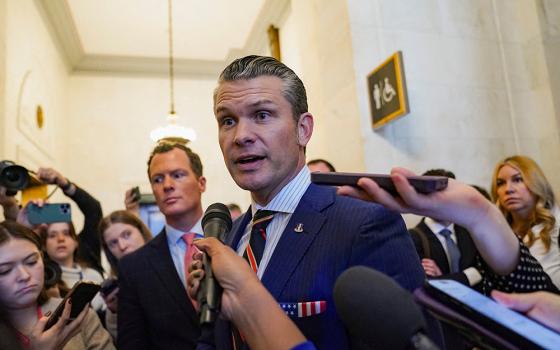Catholic hunger for pastoral leadership was clearly on display in Italy earlier this month when some 200,000 mourners reportedly turned out in Milan to show their respects for Cardinal Carlo Maria Martini, who died Aug. 31st, at the age of 85.
Martini retired ten years before his death, in 2002, after heading the northern Italy archdiocese for 22 years.
“Observers were stunned when around 200,000 people queued outside Milan’s cathedral to pay their tribute to the remains of the deceased cardinal last weekend,” wrote Alessandro Speciale for Religion News Service.
“The warm send-off was in stark contrast to what was perceived as a Vatican cold shoulder. Neither [Pope] Benedict nor his No. 2, Cardinal Tarcisio Bertone, attended Martini’s funeral Sept. 3, and Benedict didn’t mention the late cardinal during his Sept. 2 Angelus prayer in St. Peter’s Square. For the funeral, Benedict sent a message praising Martini’s ‘great openness of spirit.’ ”
Perhaps that is too harsh a judgment. There’s no reason to believe Pope Benedict had anything but personal admiration for Martini. The wider point, however, is that the two men have had very different visions of church.
This was especially clear from a Martini interview that appeared in an Italian newspaper just after his death.
The leading daily Italian newspaper, Corriere della Sera, printed a conversation Martini had with a reporter two week’s earlier. In that interview Martini criticized the church -- and by implication its current leadership -- for being “200 years out of date.”
“Our culture has aged, our churches are big and empty and the church bureaucracy rises up, our rituals and our cassocks are pompous,” Martini said. “The church must admit its mistakes and begin a radical change, starting from the pope and the bishops. The pedophilia scandals oblige us to take a journey of transformation.”
He was described in one report as our “last liberal” bishop. I would say he should be remembered as a pastoral leader, meaning he understood and could relate to ordinary Catholics, expressing openly their hopes and pains, encouraging them on the life journeys.
The Vatican Council, which opened 50 years ago next month, spawned a generation of pastoral bishops, like Martini, whose eyes and missions were focused primarily on people and the world they lived in. That generation has retired now and has been replaced by another generation of bishops, primarily focused on preserving the church and its structures.
In these shifts of emphasis, countless millions of Catholics have lost the sense that their bishops really understand them or represent them and their faith lives and aspirations.
Most often, new bishops aren’t selected from within the dioceses they will serve; they are almost entirely imposed from without. Instead of representing the faith lives of those in the local church, they represent the doctrinal priorities of the bishop of Rome.
Why have our pastoral bishops disappeared, virtually to the last one?
The answer goes back to Pope John Paul II. During his 26-and-a-half-year papacy, he consistently appointed conservative bishops. He was single-minded in his determination, unlike his immediate predecessors who appointed a mix of conservative, moderate and progressive prelates.
A notable exception to John Paul’s mindset of selecting bishops who reflected his own institutional views was Martini himself, chosen to head the Milan archdiocese Dec. 29, 1979 -- only 439 days after John Paul’s election Oct. 16, 1978.
Martini, the exception, makes the case. It took several years for John Paul to seize fully the reins of the papacy, to season his diplomatic corps with his appointments, and to make episcopal selections based on feedback from these channels.
In the United States, the shift in papal priorities became most visible with the papal appointment of Archbishop Pio Laghi as apostolic delegate to the United States.
Laghi replaced Archbishop Jean Jadot, who had had a history of selecting pastorally-minded bishops. Explaining the difference between Jadot and Laghi bishops, Msgr. John Tracy Ellis once told NCR: “I would characterize the Laghi bishops as theologically correct, meaning that they follow the line of the Holy See. They don’t vary or wander away...I don’t think a man of very liberal sentiments and views would have a chance at all.”
In the same light I recall a conversation I once had with the late Cardinal Joseph Bernardin, appointed by John Paul as archbishop of Chicago in July 1982 following the death of Cardinal John Patrick Cody in April of that year.
Bernardin confided he didn’t think he would ever have been appointed to the Chicago post had Cody died six months later.
Bernardin, viewed widely as a pastoral moderate, recalled for me the shift in the tenor of episcopal appointments taking place by 1983. Most notably John Paul installed Bernard Law as Boston archbishop and John O’Connor as New York archbishop in March 1984.
Bernardin and Martini were collaborators. The Chicago prelate would seek out his Italian counterpart during visits to Europe. Also in the ranks of close colleagues was Cardinal Basil Hume, the Benedictine monk, appointed by Pope Paul VI in February 1976 as Archbishop of Westminster, the highest ranking Catholic prelate in England and Wales. Hume was a moderate with a pastoral inclination.
Bernardin died in November 1996; Hume in June 1999.
John Paul was an ideologue. He became personally involved in key episcopal appointments. He insisted on loyalty to the Holy See, as well as selecting candidates who would uphold church teachings on matters of sexuality and gender.
To become a bishop under John Paul a candidate needed to affirm opposition to artificial contraception as proclaimed in the 1968 encyclical, Humanae vitae; to affirm church teaching on clerical celibacy; and to affirm opposition to the ordination of women. Especially the latter two litmus tests solidified as a body of bishops as men unlikely ever to question church governing structures.
John Paul II’s imprint on the Catholic episcopacy after a quarter century as pope was unparalleled. He appointed 231 cardinals and more than 75 percent of the church’s bishops.
Of course, he groomed his successor, selecting Joseph Ratzinger as Prefect of the Congregation for the Doctrine of the Faith in 1981. It was a position he held until the 2005 conclave that chose him as Pope Benedict XVI. At the time of that conclave Ratzinger was one of only three cardinals under the age of 80 not chosen by John Paul.
We are living with bishops diligently selected by a pontiff with a single-minded episcopal agenda. A church once defined by pastoral leadership is a distant memory.
So five years into the papacy of Benedict, have selections changed? Can pastoral priests or liberal bishops move up the ladder? It seems unlikely.
NCR senior correspondent John Allen, assessing Benedict's bishop appointments, offers only modest relief. Commenting on the appointment of Archbishop Jose Gomez to Los Angeles in 2010, he wrote: "At least in the most important dioceses in the United States, [the appointee] would seem to be a conservative pastor — as opposed to a conservative ideologue."
Was Martini the last liberal bishop? I don’t know that, but he may have been the last pastoral bishop.
[Tom Fox is NCR publisher. His email address is tfox@ncronline.org.]




